OLD TIME RADIO - 1 CD - 5 mp3 - Total Playtime: 1:30:59
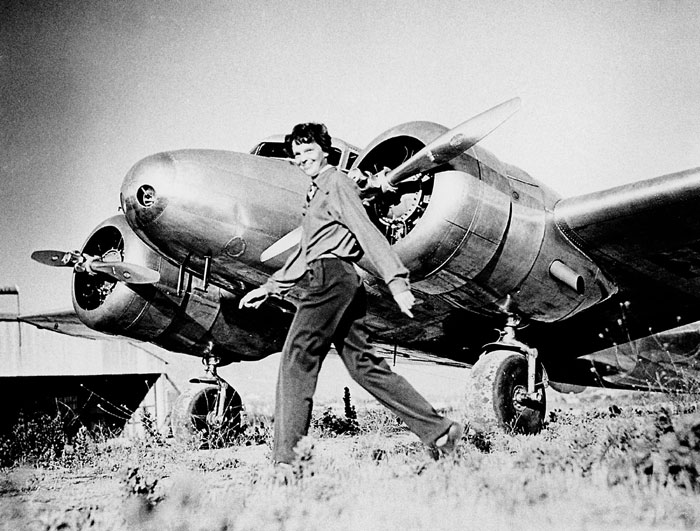
Aviator Amelia Earhart was born on July 24, 1897 in Atchison, Kansas. In 1923, Earhart, fondly known as "Lady Lindy," became the 16th woman to be issued a pilot's license. She had several notable flights, becoming the first woman to fly across the Atlantic Ocean in 1928, as well as the first person to fly over both the Atlantic and Pacific. In 1937, she mysteriously disappeared while trying to circumnavigate the globe from the equator. Since then, several theories have formed regarding Earhart's last days, many of which have been connected to various artifacts that have been found on Pacific islands—including clothing, tools and, more recently, freckle cream. Earhart was legally declared dead in 1939.
Early Life
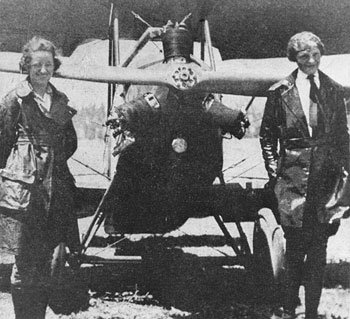 Amelia Earhart was born on July 24, 1897 in Atchison, Kansas, in America's heartland. She spent much of her early childhood in the upper-middle class household of her maternal grandparents. Amelia's mother, Amelia "Amy" Otis, married a man who showed much promise, but had never been able to break the bonds of alcohol. Edwin Earhart was on a constant search to establish his career and put the family on a firm financial foundation. When the situation got bad, Amy would shuttle Amelia and her sister Muriel to their grandparents' home. There they sought out adventures, exploring the neighborhood, climbing trees, hunting for rats, and taking breathtaking rides on Amelia's sled.
Amelia Earhart was born on July 24, 1897 in Atchison, Kansas, in America's heartland. She spent much of her early childhood in the upper-middle class household of her maternal grandparents. Amelia's mother, Amelia "Amy" Otis, married a man who showed much promise, but had never been able to break the bonds of alcohol. Edwin Earhart was on a constant search to establish his career and put the family on a firm financial foundation. When the situation got bad, Amy would shuttle Amelia and her sister Muriel to their grandparents' home. There they sought out adventures, exploring the neighborhood, climbing trees, hunting for rats, and taking breathtaking rides on Amelia's sled.
Even after the family was reunited when Amelia was 10, Edwin constantly struggled to find and maintain gainful employment. This caused the family to move around, and Amelia attended several different schools. She showed early aptitude in school for science and sports, though it was difficult to do well academically and make friends. In 1915, Amy separated once again from her husband, and moved Amelia and her sister to Chicago to live with friends. While there, Amelia attended Hyde Park High School, where she excelled in chemistry. Her father's inability to be the provider for the family led Amelia to become independent and not rely on someone else to "take care" of her.
After graduation, Amelia Earhart spent a Christmas vacation visiting her sister in Toronto, Canada. After seeing wounded soldiers returning from World War I, she volunteered as a nurse's aide for the Red Cross. Earhart came to know many of the wounded who were pilots. She developed a strong admiration for aviators, spending much of her free time watching the Royal Flying Corps practicing at the airfield nearby. In 1919, Earhart enrolled in medical studies at Columbia University. She quit a year later to be with her parents, who had reunited in California.
Early Career
At a Long Beach air show in 1920, Amelia Earhart took a plane ride that transformed her life. It was only 10 minutes, but when she landed she knew she had to learn to fly. Working at a variety of jobs, from photographer to truck driver, she earned enough money to take flying lessons from pioneer female aviator Anita "Neta" Snook. Earhart immersed herself in learning to fly. She read everything she could find on flying, and spent much of her time at the airfield. She cropped her hair short, in the style of other women aviators. Worried what the other, more experienced pilots might think of her, she even slept in her new leather jacket for three nights to give it a more "worn" look.
In the summer of 1921, Earhart purchased a second-hand Kinner Airster biplane painted bright yellow. She nicknamed it "The Canary," and set out to make a name for herself in aviation. On October 22, 1922, she flew her plane to 14,000 feet—the world altitude record for female pilots. On May 15, 1923, Amelia Earhart became the 16th woman to be issued a pilot's license by the world governing body for aeronautics, The Federation Aeronautique.
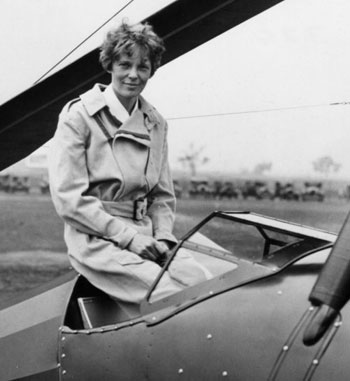 Throughout this period, the Earhart family lived mostly on an inheritance from Amy's mother's estate. Amy administered the funds but, by 1924, the money had run out. With no immediate prospects of making a living flying, Amelia Earhart sold her plane. Following her parents' divorce, she and her mother set out on a trip across the country starting in California and ending up in Boston. In 1925 she again enrolled in Columbia University, but was forced to abandon her studies due to limited finances. Earhart found employment first as a teacher, then as a social worker.
Throughout this period, the Earhart family lived mostly on an inheritance from Amy's mother's estate. Amy administered the funds but, by 1924, the money had run out. With no immediate prospects of making a living flying, Amelia Earhart sold her plane. Following her parents' divorce, she and her mother set out on a trip across the country starting in California and ending up in Boston. In 1925 she again enrolled in Columbia University, but was forced to abandon her studies due to limited finances. Earhart found employment first as a teacher, then as a social worker.
Earhart gradually got back into aviation in 1927, becoming a member of the American Aeronautical Society's Boston chapter. She also invested a small amount of money in the Dennison Airport in Massachusetts, and acted as a sales representative for Kinner airplanes in the Boston area. She also wrote articles promoting flying in the local newspaper and began to develop a following as a local celebrity.
First Transatlantic Flight
After Charles Lindbergh's solo flight from New York to Paris in May 1927, interest grew for having a woman fly across the Atlantic. In April 1928, Amelia Earhart received a phone call from Captain Hilton H. Railey, a pilot and publicity man, asking her, "Would you like to fly the Atlantic?" In a heartbeat she said "yes." She traveled to New York to be interviewed, and met with project coordinators, including publisher George P. Putnam. Soon she was selected to be the first woman on a transatlantic flight ... as a passenger. The wisdom at the time was that such a flight was too dangerous for a woman to conduct herself.
On June 17, 1928, Amelia Earhart took off from Trespassey Harbor, Newfoundland, in a Fokker F.Vllb/3m named Friendship. Accompanying her on the flight was pilot Wilmer "Bill" Stultz and co-pilot/mechanic Louis E. "Slim" Gordon. Approximately 20 hours and 40 minutes later, they touched down at Burry Point, Wales, in the United Kingdom. Due to the weather, Stultz did all the flying. Even though this was the agreed upon arrangement, Earhart later confided that she felt she "was just baggage, like a sack of potatoes." Then she added, "... maybe someday I'll try it alone."
The Friendship team returned to the United States, greeted by a ticker-tape parade in New York, and later a reception held in their honor with President Calvin Coolidge at the White House.The press dubbed her "Lady Lindy," a derivative of the "Lucky Lind," nickname for Charles Lindbergh. George Putnam had already published several writings by Lindbergh, and he saw Earhart's flight as a bestselling story with Amelia as the star. Thus began their personal and professional relationship. Putnam started to heavily promote her through a book, lecture tours, and product endorsements. Earhart actively became involved in the promotions, especially woman's fashions. For years she had sewn her own clothes, and now she contributed her input to new line of women's fashion that embodied a sleek and purposeful, yet feminine, look.
Through her celebrity endorsements, she gained notoriety and acceptance in the public eye. She accepted a position as associate editor at Cosmopolitan magazine, using the media outlet to campaign for commercial air travel. From this forum, she became a promoter for Transcontinental Air Transport, later known as Trans World Airlines (TWA), and was a vice president of National Airways, which flew routes in the northeast.
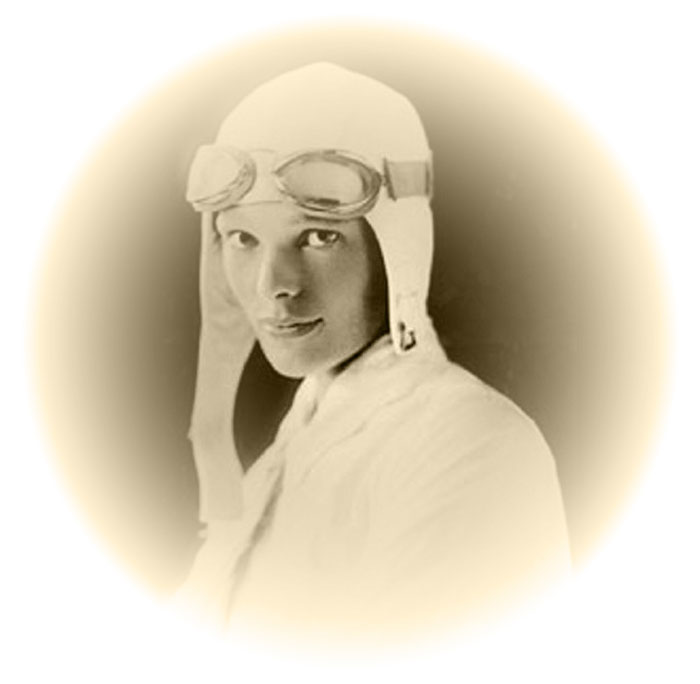
Not content with just celebrity status, Amelia set her sights on establishing herself as a respected aviator. Shortly after returning from the transatlantic fight, she set off on a successful solo flight across North America. In 1929, she entered the first Santa Monica-to-Cleveland Woman's Air Derby, and placed third. In 1931, Earhart powered a Pitcairn PCA-2 autogyro and set a world altitude record of 18,415 feet. During this time, Earhart became involved with the Ninety-Nines, an organization of female pilots advancing the cause of women in aviation. She became the organization's first president in 1930.
Personal Life
Rumors of an affair with George Putnam led to speculation that Amelia Earhart was responsible for the destruction of his marriage in 1929. But the couple insisted the early part of their relationship was strictly professional. After his divorce, Putnam actively pursued Earhart, and eventually fell in love with her. He asked her to marry him on several occasions, but Earhart declined.
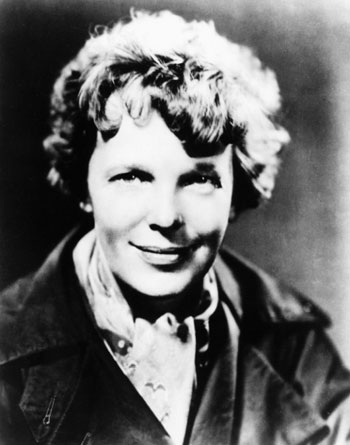 Finally, on February 7, 1931, Putnam and Earhart were wed in Putnam's mother's home in Connecticut. Earhart referred to their marriage as a partnership with dual control. On the day of their wedding, she wrote a letter to Putnam telling him, "I want you to understand I shall not hold you to any medieval code of faithfulness to me nor shall I consider myself bound to you similarly."
Finally, on February 7, 1931, Putnam and Earhart were wed in Putnam's mother's home in Connecticut. Earhart referred to their marriage as a partnership with dual control. On the day of their wedding, she wrote a letter to Putnam telling him, "I want you to understand I shall not hold you to any medieval code of faithfulness to me nor shall I consider myself bound to you similarly."
First Solo Flight Across the Atlantic
Amelia Earhart's public persona presented a gracious, if somewhat shy, woman who displayed remarkable talent and bravery. Yet deep inside, Earhart harbored a burning desire to distinguish herself as different from the rest of the world. She was an intelligent and competent pilot who never panicked or lost her nerve, but she was not a brilliant aviator. Her skills kept pace with aviation during the first decade of the century but, as technology moved forward with sophisticated radio and navigation equipment, Earhart continued to fly by instinct.She recognized her limitations and continuously worked to improve her skills, but the constant promotion and touring never gave her the time she needed to catch up. Recognizing the power of her celebrity, she strove to be an example of courage, intelligence and self-reliance. She hoped her influence would help topple negative stereotypes about women, and open doors for them in every field.
Sometime before their marriage, Earhart and Putnam worked on secret plans for a solo flight across the Atlantic Ocean. By early 1932, they had made their preparations. They announced that on the fifth anniversary of Charles Lindbergh's flight across the Atlantic, Amelia would attempt the same feat. On the morning of May 20, 1932, she took off from Harbour Grace, Newfoundland, with that day's copy of the local newspaper to confirm the date of the flight.
Almost immediately, the flight ran into difficulty as she encountered thick clouds and ice on the wings. After about 12 hours the conditions got worse, and the plane began to experience mechanical difficulties. She knew she wasn't going to make it to Paris as Lindbergh had, so she started looking for a new place to land. She found a pasture just outside the small village of Culmore, in Londonderry, Northern Ireland, and successfully landed. On May 22, 1932, she made an appearance at the Hanworth Airfield in London, where she received a warm welcome from local residents. Earhart's nearly 15-hour flight established her as an international hero, as she became the first woman to fly solo across the Atlantic. Earhart As a result, Earhart won many honors, including the Gold Medal from the National Geographic Society as presented by President Hoover, the Distinguished Flying Cross from the U.S. Congress, and the Cross of the Knight of the Legion of Honor from the French government.
Several other notable flights followed for Amelia Earhart, including a solo trip from Honolulu, Hawaii, to Oakland, California. This flight established her as the first woman—as well as the first person—to fly both across the Atlantic and the Pacific oceans. In April 1935, Earhart flew solo from Los Angeles to Mexico City, and a month later she flew from Mexico City to New York. Between 1930 and 1935, Amelia Earhart set seven women's speed and distance aviation records in a variety of aircraft. By 1935, Earhart began to contemplate one last fight that would set her apart for all others: to circle the world.
Earhart's Final Flight
In 1935, Amelia Earhart joined the faculty at Purdue University as a female career consultant, and technical advisor to the Department of Aeronautics. This partnership helped finance the purchase of a Lockheed Electra L-10E plane. While she would not be the first person to circumnavigate the earth, she decided she would be the first to do it around the equator. She pulled together a top-rated crew of three men: Captain Harry Manning, Fred Noonan, and Paul Mantz. Manning had been the captain of the President Roosevelt, which brought her back from Europe in 1928, and would become Earhart's first navigator. Noonan had vast experience in both marine and flight navigation, and was to be the second navigator. Mantz, a Hollywood stunt pilot, and was chosen to be Earhart's technical advisor.
The original plan was to take off from Oakland, California, and fly west to Hawaii. From there, the group would fly across the Pacific Ocean to Australia. Then they would cross the sub-continent of India, on to Africa, then to Florida, and back to California.
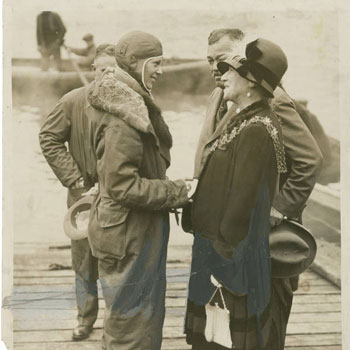 On March 17, 1937, they took off from Oakland on the first leg. They experienced some periodic problems flying across the Pacific, and landed in Hawaii for some repairs at the United States Navy's Field on Ford Island in Pearl Harbor. After three days, the Electra began its takeoff, but something went wrong. Earhart lost control, and looped the plane on the runway. How this happened is still the subject of some controversy. Several witnesses, including an Associated Press journalist, said they saw a tire blow. Other sources, including Paul Mantz, indicated it was pilot error. Though no one was seriously hurt, the plane was severely damaged and had to be shipped back to California for extensive repairs.
On March 17, 1937, they took off from Oakland on the first leg. They experienced some periodic problems flying across the Pacific, and landed in Hawaii for some repairs at the United States Navy's Field on Ford Island in Pearl Harbor. After three days, the Electra began its takeoff, but something went wrong. Earhart lost control, and looped the plane on the runway. How this happened is still the subject of some controversy. Several witnesses, including an Associated Press journalist, said they saw a tire blow. Other sources, including Paul Mantz, indicated it was pilot error. Though no one was seriously hurt, the plane was severely damaged and had to be shipped back to California for extensive repairs.
In the interim, Earhart and Putnam secured additional funding for a new flight. The stress of the delay and the grueling fund-raising appearances left Amelia exhausted. By the time the plane was repaired, weather patterns and global wind changes required alterations to the flight plan. This time Earhart and her crew would fly east. Captain Harry Manning would not join the team, due to previous commitments. Paul Mantz was also absent, reportedly due to a contract dispute.
After flying from Oakland to Miami, Florida, Earhart and Noonan took off on June 1st from Miami with much fanfare and publicity. The plane flew toward Central and South America, turning east for Africa. From there, the plane crossed the Indian Ocean and finally touched down in Lae, New Guinea, on June 29, 1937. About 22,000 miles of the journey had been completed. The remaining 7,000 miles would take place over the Pacific.
In Lae, Earhart contracted dysentery that lasted for days. While she recuperated, several necessary adjustments were made to the plane. Extra amounts of fuel were stowed on board. The parachutes were packed away, for there would be no need for them while flying along the vast and desolate Pacific Ocean.
The flyer's plan was to head to Howland Island, 2,556 miles away, situated between Hawaii and Australia. A flat sliver of land 6,500 feet long, 1,600 feet wide, and no more than 20 ft. above the ocean waves, the island would be hard to distinguish from the similar looking cloud shapes. To meet this challenge, Earhart and Noonan had an elaborate plan with several contingencies. Celestial navigation would be used to track their route and keep them on course. In case of overcast skies, they had radio communication with a U.S. Coast Guard vessel, Itasca, stationed off Howland Island. They could also use their maps, compass, and the position of the rising sun to make an educated guess in finding their position relative to Howland Island. After aligning themselves with Howland's correct latitude, they would run north and south looking for the island and the smoke plume to be sent up by the Itasca. They even had emergency plans to ditch the plane if need be, believing the empty fuel tanks would give the plane some buoyancy, as well as time to get into their small inflatable raft to wait for rescue.
Earhart and Noonan set out from Lae on July 2, 1937, at 12:30 PM, heading east toward Howland Island. Though the flyers seemed to have a well thought-out plan, several early decisions led to grave consequences later on. Radio equipment with shorter wavelength frequencies were left behind, presumably to allow more room for fuel canisters. This equipment could broadcast radio signals farther distances. Due to inadequate quantities of high-octane fuel, the Electra carried about 1,000 gallons—50 gallons short of full capacity.
The Electra's crew ran into difficulty almost from the start. Witnesses to the July 2 take off reported that a radio antenna may have been damaged. It is also believed that due to the extensive overcast conditions, Noonan might have had extreme difficulty with celestial navigation. If that weren't enough, it was later discovered that the flyers were using maps that may have been inaccurate. According to experts, evidence shows that the charts used by Noonan and Earhart placed Howland Island nearly six miles off its actual position.
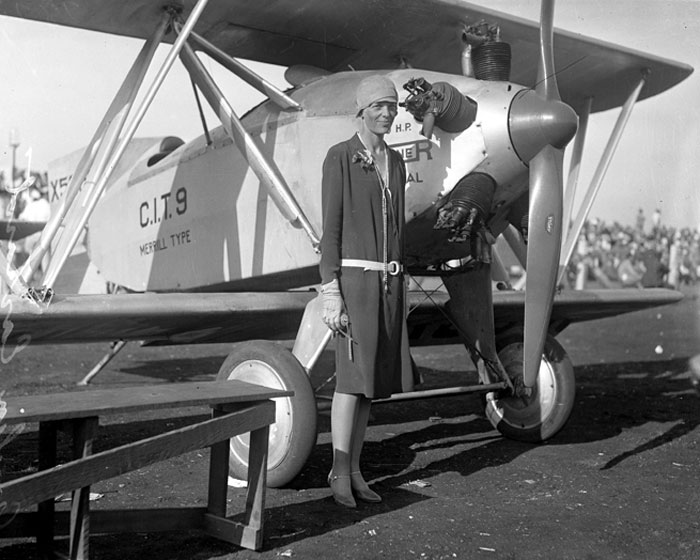
These circumstances led to a series of problems that couldn't be solved. As Earhart and Noonan reached the supposed position of Howland Island, they maneuvered into their north and south tracking route to find the island. They looked for visual and auditory signals from the Itasca, but for various reasons radio communication was very poor that day. There was also confusion between Earhart and the Itasca over which frequencies to use, and a misunderstanding as to the agreed upon check-in time; the flyers were operating on Greenwich Civil Time and the Itasca was operating on the naval time zone, which set their schedules 30 minutes apart.
On the morning of July 3, 1937, at 7:20 AM, Amelia reported her position, placing the Electra on course at 20 miles southwest of the Nukumanu Islands. At 7:42 AM the Itasca picked up this message from the Earhart, "We must be on you, but we cannot see you. Fuel is running low. Been unable to reach you by radio. We are flying at 1,000 feet." The ship replied but there was no indication that Earhart heard this. The flyers' last communication was at 8:43 AM. Though the transmission was marked as "questionable," it is believed Earhart and Noonan thought they were running along the north, south line. However, Noonan's chart of Howland's position was off by five nautical miles. The Itasca released its oil burners in an attempt to signal the flyers, but they apparently did not see it. In all likelihood, their tanks ran out of fuel and they had to ditch at sea.
Disappearance and Theories
Realizing they had no more contact, the Itasca began an immediate search. Despite the efforts of 66 aircraft and nine ships—an estimated $4 million rescue authorized by President Franklin D. Roosevelt—the fate of the two flyers remained a mystery. The official search ended on July 18th, 1937, but George Putnam financed additional search efforts, working off tips of naval experts and even psychics in an attempt to find his wife. In October 1937, he acknowledged that any chance of Earhart and Noonan surviving was gone. On January 5, 1939, Amelia Earhart was declared legally dead by the Superior Court in Los Angeles.
Many theories emerged after the disappearance of Amelia Earhart and Fred Noonan. Some believed Earhart was on a spy mission to the Marshall Islands authorized by President Roosevelt, and was captured by Japanese troops. This theory extended to claiming that Earhart was forced to broadcast to American GIs as "Tokyo Rose" during World War II. Another theory claims she purposely crashed the plane into the Pacific on a suicide run.
There are two theories that seem to have the greatest credibility. One is that the Electra Earhart and Noonan were flying was ditched or crashed, and the two perished at sea. Several aviation and navigation experts support this theory concluding that the outcome of the last leg of the flight came down to "poor planning, worse execution." Investigations concluded that the Electra aircraft was not fully fueled, and couldn't have made it to Howland Island even if conditions were ideal. The fact that there were so many issues creating difficulties lead investigators to the conclusion that the plane simply ran out of fuel some 35 to 100 miles off the coast of Howland Island.
Another theory that gained credibility, due to recent physical evidence, is that Earhart and Noonan might have flown without radio transmission for some time after their last radio signal, landing at uninhabited Gardner Island (now known as Nikularoro). This island is where they would ultimately die. This theory is based on several on-site investigations that have turned up artifacts such as improvised tools, bits of clothing, an aluminum panel, and a piece of Plexiglas the exact width and curvature of an Electra window. Most recently, in May 2012, investigators found a jar of freckle cream on a remote island in the South Pacific, in proximity to their other findings. Many investigators believe the cream belonged to Earhart.
Legacy
Earhart's life and career have been celebrated for the past several decades on "Amelia Earhart Day," which is held annually on July 24—her birthday in 1897. Earhart would have celebrated her 115th birthday on July 24, 2012.
Amelia Earhart possessed a shy, charismatic appeal that belied her determination and ambition. In her passion for flying, she amassed a number of distance and altitude world records. But beyond her accomplishments as a pilot, she also wanted to make a statement about the role and worth of women. She dedicated much of her life to prove that, like men, women could excel in their chosen professions, and that they could have equal value. This all contributed to her wide appeal and international celebrity. Her mysterious disappearance, added to all of this, has given Earhart lasting recognition in popular culture as one of the world's most famous pilots.
Achievements
January 3, 1921 - Began flying lessons with Neta Snook
July 1921 - Bought first plane, Kinner Airster (Canary)
October 22, 1922 - Broke women's altitude record when she rose to 14,000 feet
June 17-18, 1928 - First woman to fly across the Atlantic; 20hrs 40min (Fokker F7, Friendship)
Summer 1928 - Bought an Avro Avian, a small English plane famous because Lady Mary Heath, Britain's foremost woman pilot had flown it solo from Capetown, South Africa to London
Fall 1928 - Published book 20 Hours 40 Minutes, toured and lectured; became aviation editor of Cosmopolitan magazine
August 1929 - Placed third in the First Women's Air Derby, aka the Powder Puff Derby; upgraded from her Avian to a Lockheed Vega
Fall 1929 - Elected as an official for National Aeronautic Association and encouraged the Federation Aeronautique Internationale (FAI) to establish separate world altitude, speed and endurance records for women
June 25, 1930 - Set women's speed record for 100 kilometers with no load, and with a load of 500 kilograms
July 5, 1930 - Set speed record for of 181.18mph over a 3K course
September 1930 - Helped to organize and became vice president of public relations for new airline, New York, Philadelphia and Washington Airways
April 8, 1931 - Set woman's autogiro altitude record with 18,415 feet (in a Pitcairn autogiro)
May 20-21, 1932 - First woman to fly solo across the Atlantic; 14 hrs 56 min (it was also the 5th anniversary of Lindberg's Atlantic flight; awarded National Geographic Society's gold medal from President Herbert Hoover; Congress awarded her the Distinguished Flying Cross; wrote For The Fun of It about her journey
August 24-25, 1932 - First woman to fly solo nonstop coast to coast; set women's nonstop transcontinental speed record, flying 2,447.8 miles in 19hrs 5min
Fall 1932 - Elected president of the Ninety Nines, a new women's aviation club which she helped to form
July 7-8, 1933 - Broke her previous transcontinental speed record by making the same flight in 17hrs 7min
January 11, 1935 - First person to solo the 2,408-mile distance across the Pacific between Honolulu and Oakland, California; also first flight where a civilian aircraft carried a two-way radio
April l9 - 20, 1935 - First person to fly solo from Los Angeles to Mexico City; 13hrs 23min
May 8, 1935 - First person to fly solo nonstop from Mexico City to Newark; 14hrs 19min
March 17, 1937 - Amelia and her navigator, Fred Noonan, along with Captain Harry Manning and stunt pilot Paul Mantz, fly the first leg of the trip from Oakland, California to Honolulu, Hawaii in 15 hours and 47 minutes
June 1, 1937 - Began flight around the world June 1937; first person to fly from the Red Sea to India
SHOWS LIST
Amelia Earhart 310200 The Pilot (14 Seconds)
Amelia Earhart 320522 Women In Air Travel (1 Minute)
Amelia Earhart 350000 On Women In Flying (2 Minutes)
Cavalcade of America 421102 Toward a Farther Star
Lux Radio Theater 370628 The Front Page
THESE ARE MP3 RECORDINGS
THEY WILL NOT PLAY IN REGULAR CD PLAYERS
CLICK HERE TO KNOW MORE ABOUT mp3
CLICK HERE TO LEARN MORE ABOUT OUR PRODUCTS
We guarantee delivery of your item. If your item doesn't get there or is damaged, please notify us and we'll reship for you.
FULL REFUND IF NOT SATISFIED
This product was added to our catalog on Sunday 29 September, 2013.
